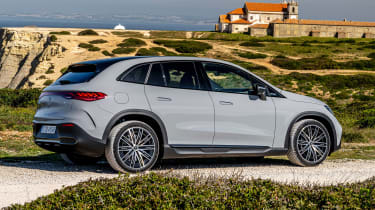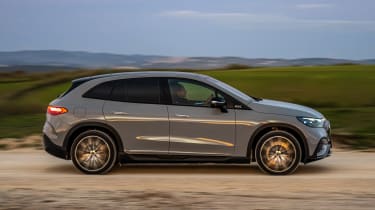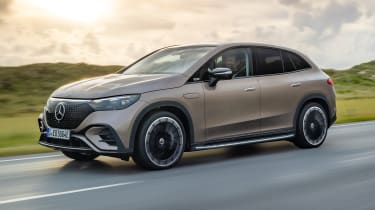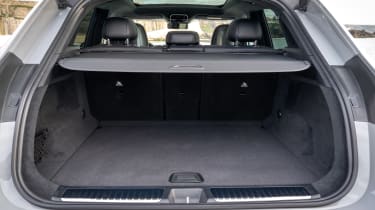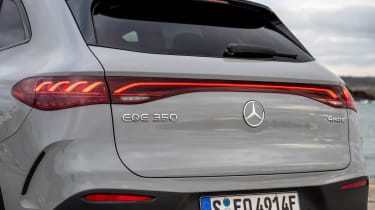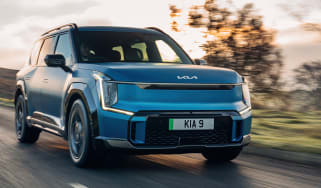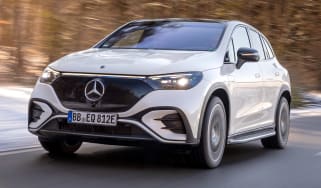Mercedes EQE SUV review
Like a top-of-the-range smartphone, the Mercedes EQE SUV boasts a giant touchscreen, fast charging, lots of storage and – to its detriment – a hefty price tag
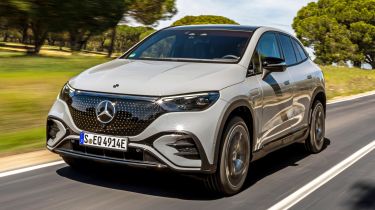
Pros
- Long range and fast charging
- Impressive technology
- Practical
Cons
- Feels heavy
- Some cheap-feeling trim
- Very expensive
| Car type | Range | Wallbox charge time | Rapid charge time |
|---|---|---|---|
| Electric | 306-334 miles | 14hrs (0-100%, 7.4kW) | 31mins (10-80%, 170kW) |
Mercedes EQE SUV verdict
If you’re of the opinion that ‘luxury’ means having all the latest technology, then you’ll be suitably impressed by the glossy screens and gizmos the EQE SUV has on offer. However, if you’re expecting it to be filled to the brim with the plushest materials available – a fair ask given the EQE’s £90,000 starting price – then you might be a bit disappointed by the electric Merc’s otherwise lacklustre interior. While the EQE SUV does offer a solid range and ultra-rapid charging, so does the significantly cheaper BMW iX, which also manages to be much better to drive and feels better-built overall. If you can live with the Beemer’s beaver-tooth design – and aren’t too fussed about the latest infotainment tech – we reckon you should skip the EQE SUV.
Range details, specs and alternatives
The main issue with initial and numerical-based car naming systems is that you'll eventually run out of letters and/or numbers. This has become the case for Mercedes when it comes to its range of EQ-badged electric cars, with the German automotive giant having to add the ‘SUV’ suffix to many of its newer models in order to try and distinguish them from their saloon counterparts.
So, with that in mind, the Mercedes EQE SUV is, as its name suggests, a jacked-up SUV version of the EQE saloon on which it’s based. Sitting above the EQA and EQC, but below the Mercedes EQS SUV in the lineup, the EQE SUV is a luxurious electric crossover, intended to rival the likes of the BMW iX, Audi Q8 e-tron and Lotus Eletre, as well as the upcoming Polestar 3.
Like a true 4x4, all versions of the EQE SUV sold in the UK at launch benefit from dual electric motors, with one on each axle providing four-wheel-drive. The entry-level EQE 350 4MATIC gets 288bhp and while this may not seem too impressive for a car that weighs over two-and-a-half tonnes, still gets from 0-62mph in 6.6 seconds thanks to the huge heap of available torque.
Next up is the EQE 500 4MATIC, which gets a more potent 402bhp powertrain and cuts the 0-62mph sprint time down to just 4.9 seconds. Finally, there’s the Mercedes-AMG EQE 53 SUV which outputs a monstrous 616bhp (or 668bhp with the optional Dynamic Plus pack), and will reach 62mph in as little as three-and-a-half seconds.
The EQE 350 4MATIC gets an 89kWh (usable) battery pack which provides a range of up to 334 miles on a single charge – depending on specification. More powerful models use a slightly larger 91kWh (usable) battery pack to offset their less-efficient motor setups.
Buyers can choose from one of four main trim levels: AMG Line, AMG Line Premium, AMG Line Premium Plus and Business Class – the former is only available with the entry-level EQE 350 powertrain. Starting at over £90,000, the EQE SUV is quite a bit more expensive than many of its key competitors; thankfully, even the base AMG Line model comes loaded with kit.

Standard specification includes full LED exterior lighting, 20-inch alloy wheels, leather upholstery, heated and ventilated front seats, a powered bootlid, a wireless charging pad and a reversing camera, plus a 12.8-inch OLED central touchscreen and 12.3-inch digital instrument cluster.
Stepping up to the AMG Line Premium trim adds larger 21-inch alloys, digital LED headlights, a panoramic sunroof, Burmester sound system and more safety aids, including a 360-degree camera system. Topping the non-AMG model range, the AMG Line Premium Plus and Business Class models cost the same, with the former adding 22-inch wheels, a head-up display and rear-axle steering. Business Class gets the same upgrades, but swaps the AMG-Line’s sporty styling and figure-hugging seats for a more comfortable, luxury-focused specification, including smaller 21-inch diamond-cut wheels for a more supple ride.
In addition to the main trim levels, the high-performance EQE 53 can be configured in either Night Edition or Touring guises, with the first taking a stealthy sporty approach and the second a more luxurious one. Both get AMG-specific styling touches including the iconic ‘Panamericana’ grille, as well as figure-hugging sports seats and performance-oriented switchgear on the steering wheel.
Perhaps the most desirable option – and by far the most expensive – is the expansive 42-inch Hyperscreen. This actually comprises three separate screens – one of the driver, one for the passenger and a huge central touchscreen – hidden behind what looks like a single pane of glass. It comes as standard on full-AMG, as well as Premium Plus and Business Class models, but otherwise costs an eye-watering £8,000; while tech geeks with deep pockets will likely fork out for this flashy setup regardless, we reckon most buyers should save the cash as the standard MBUX setup is already fantastic and isn’t quite as distracting on the move.
Range, battery size & charging
| Model | Range | Wallbox charge time | Rapid charge time |
|---|---|---|---|
| EQE 350 4MATIC | 306-334 miles | 14hrs (0-100%, 7.4kW) | 31mins (10-80%, 170kW) |
| EQE 500 4MATIC | 308-325 miles | 14hrs (0-100%, 7.4kW) | 31mins (10-80%, 170kW) |
| EQE 53 | 278 miles | 14hrs (0-100%, 7.4kW) | 31mins (10-80%, 170kW) |
Entry-level 350 4MATIC versions of the Mercedes EQE SUV come equipped with an 89kWh (usable) battery – enough for a range of up to 334 miles, depending on specification. Of course, buyers should take this figure with a pinch of salt and budget for around 280–300 miles in most conditions.
The more-powerful EQE 500 4MATIC can only manage up to 325 miles on the combined WLTP tests with a slightly larger 91kWh battery setup, and only 308 miles in range-topping Premium Plus specification with its 22-inch alloy wheels. AMG 53 models can only muster roughly 278 miles before needing to be plugged-in, however, it goes without saying that making use of the extra grunt that’s on offer will quickly take its toll on your level of charge.
Ultra-rapid DC charging at speeds of up to 170kW is standard on the EQE SUV, meaning 130 miles of range can be added in as little as 15 minutes. Plug into a slower 50kW charger – these are a little more common – and a 10-80% charge will take around 90 minutes.
Most of the time you’ll likely be topping-up at home via a 7.4kW wallbox, with a full charge taking 14 hours. A three-pin plug will take significantly longer (almost 40 hours) – though this will be a last resort for most owners.
Running costs & insurance
The Mercedes EQE SUV is a very expensive car, costing around £20,000 more than an entry-level BMW iX. While like all electric cars, the EQE SUV is exempt from road tax (VED) and the London Congestion Charge until 2025, this does little to offset its astronomical asking price.
This is because, despite the fact Merc hasn’t published insurance groups for the EQE SUV yet, its saloon sibling sits in the most expensive group 50, and it’s unlikely the SUV will be any different. The EQE’s large battery pack also means charging up may not be quite as cheap as you might expect – especially if you frequently use public charge points.
Plus, while the EQE’s battery is covered by a 10-year warranty, Merc’s three years of cover for the rest of the car can’t come close to the seven-year guarantee offered for the more mainstream Kia EV6.
Performance, motor & drive
| Model | 0-62mph | Top speed | Driven wheels | Power |
|---|---|---|---|---|
| EQE 350 4MATIC | 6.6s | 130mph | Four | 288bhp |
| EQE 500 4MATIC | 4.9s | 130mph | Four | 402bhp |
| EQE 53 | 3.7s | 137mph | Four | 616bhp |
Aside from the top-spec AMG 53 variant (we’ll get onto that later), there are two main EQE SUV variants available to UK buyers: the 288bhp EQE 350 and the 402bhp EQE 500. Performance from both is smooth and instant, if not quite neck-snapping, which is impressive given the EQE weighs over two-and-a-half tonnes.
The top-of-the-line Mercedes-AMG EQE 53 SUV feels as ballistic as its generous 1,000Nm helping of torque might suggest. As standard, this produces 616bhp and gets from 0-62mph in 3.7 seconds; add the optional Dynamic Plus pack and power grows to a hefty 668bhp and the 0-62mph time shrinks by 0.2 seconds.
AMG’s performance-oriented tune of the EQE SUV does wonders in making it feel fun to drive on a twisty road; there isn’t much body lean, which isn’t something that can be said about the standard, softer 350 and 500 variants. All versions offer sharp and direct steering though, plus standard-fit air suspension provides a supple ride. Either way, a BMW iX feels much more nimble on a twisty road, despite weighing roughly the same.
Interior, dashboard & infotainment
Undoubtedly what will draw most buyers to the Mercedes EQE SUV is its high-tech interior. As standard, the electric Merc gets a 12.3-inch digital instrument cluster, alongside a 12.8-inch portrait touchscreen, both pulled straight out of the Mercedes S-Class limousine. Mercedes’ MBUX system is one of the best in the business and this setup is perhaps its best implementation; the digital instrument cluster is highly configurable, while the main touchscreen is incredibly vivid (thanks to OLED technology) and responds just as quickly as the latest smartphones.
Many buyers won’t be content with this, though, and will pine after the cutting-edge Hyperscreen setup, which comprises three separate screens integrated into one giant panel. In reality, while this certainly looks stunning and is almost unlike anything else in the car industry right now, it doesn’t add much extra functionality, bar an additional screen for the front passenger. Costing £8,000 to upgrade on AMG Line Premium models – Premium Plus and Business Class cars get this as standard – we’d save the money, especially given how expensive the EQE SUV is in the first place.
Look past the flashy screens, though, and you’ll find that the EQE SUV doesn’t quite feel as plush as you might expect from a £90,000 Mercedes. While there is certainly plenty of sumptuous leather and premium-feeling metal trim, there’s also rather a few cheap-feeling plastics that appear as if they’ve been pulled straight out of a much cheaper Mercedes model. The EQE doesn’t quite feel as well screwed-together as its Audi Q8 e-tron rival, either, with some panels feeling rather flimsy and hollow.
Boot space, seating & practicality
| Length | Width | Height | Boot volume (seats up/down) |
|---|---|---|---|
| 4,863mm | 1,940mm | 1,685mm | 520/1,675 litres |
Despite not being the largest SUV in Mercedes’ electric car lineup, the EQE SUV is still a big car and is just as practical as you might expect. There’s space in the rear to sit adults three abreast, which is only helped by the car’s flat floor. Headroom is good too, even with the EQE’s slightly sloping roofline and the optional panoramic roof fitted.
Open the standard-fit electric tailgate and you’ll be greeted with 520 litres of load space, which is somewhere in between what you’d get in the slightly less practical BMW iX and the more spacious Audi Q8 e-tron. There’s plenty of hooks for tying down loose objects, while there’s even some storage under the floor for charging cables, which makes up for the fact that there’s no ‘frunk’ under the bonnet. The boot is a good square shape overall, plus folding down the rear seats increases the space to 1,675 litres.
Reliability & safety rating
Mercedes-Benz has a reputation for producing top-quality cars, however, the brand placed a disappointing 25th out of 32 manufacturers in our 2023 Driver Power customer satisfaction survey. There isn’t any data on the EQE SUV yet given it’s so new, although over 28% of Mercedes owners reported a fault with their car within the first year of ownership, which is slightly above average.
The EQE SUV is yet to undergo safety testing by Euro NCAP, but its saloon counterpart managed to score a full five stars, putting the SUV in good stead. All EQE SUV models come as standard with autonomous emergency braking (AEB), as well as lane-keep assist, blind spot monitoring, automatic high beams and a reversing camera. Cars specified in Premium trim and above also get access to the Driving Assistance Package Plus which includes digital LED headlights that can shut off parts of the high beam so as to avoid dazzling oncoming drivers, in addition to an automatic speed limiter, traffic sign recognition, a 360-degree camera and active steering and braking assistance, which will autonomously perform evasive manoeuvres in the event of an accident.

